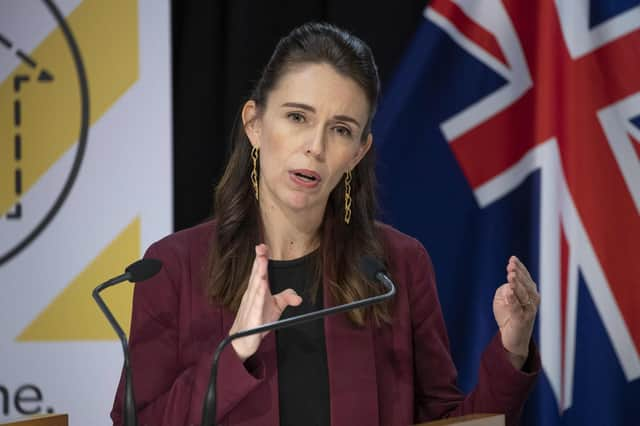How has New Zealand 'eliminated' Covid-19 and what lessons can Scotland learn?


It has been a hard won battle, with the nation’s government imposing sweeping lockdown restrictions condemned by some opposition politicians as unnecessarily “harsh,” and the war is far from over.
But with its Covid-19 death toll standing at just 19 to date, New Zealand’s approach to tackling the global pandemic has been hailed as an exemplar.
Advertisement
Hide AdAdvertisement
Hide AdUnfortunately, the question of what other countries might be able to learn from it is one which must be predominantly asked in hindsight, although it is clear New Zealand has been much more aggressive in terms of travel restrictions and testing, factors which could still have a sizeable influence on the spread of the virus elsewhere.
Up until the middle of last month, New Zealand had been largely adhering to a strategy designed to manage influenza pandemics, but on 23 March - by which point the number of confirmed cases topped 100 - it changed tack.
Prime minister Jacinda Ardern announced a rapid escalation in physical distancing and travel restrictions, which effectively put in place a mass home quarantine programme for the following month. “We must go hard and we must go early,” she insisted.
While many of the measures have since become familiar around the world, New Zealand’s approach was especially aggressive. It closed its borders, except to its citizens and residents, and even they were required to quarantine or self-isolate for 14 days upon entry, a stipulation which was tightened even further as the weeks wore on.
Such strict actions went hand in hand with isolation tactics and widespread testing for anyone who was suspected of being exposed, along with a programme of contact tracing.
As a consequence, a country with a population of just under five million people has registered just 1,122 confirmed cases, with a further 347 probable cases. Just seven people are in New Zealand’s hospitals receiving treatment for Covid-19. The numbers are the result of design, not accident; modelling indicated the nation could have had more than 1,000 cases a day if it had not brought in the lockdown so early, Ms Ardern has pointed out.
While the likes of the UK and US governments have been criticised for ramping up Covid-19 testing too late, New Zealand marshalled its resources to carryout close to 124,000 tests to date, having launched the programme on 22 January.
Scotland has tested just 49,000 people so far, while across the UK as a whole - which has a population around 13 times the size of New Zealand’s - the number of tests carried out stands at just under 670,000.
Advertisement
Hide AdAdvertisement
Hide AdMuch like Ms Ardern, First Minister Nicola Sturgeon has been praised for her clear, consistent, and calm messaging throughout the crisis.
The former, and her administration, has doubtless benefited from some geographical advantages. Although the two countries share a similar size of population, New Zealand is more remote, and has fewer flight routes than the UK.
And for all that the infection and death statistics are favourable compared with the vast majority of other countries around the world, there are concerns over the lasting economic impact in New Zealand resulting from its swift and severe lockdown restrictions.
For now, the nation - buoyed by the Covid-19 data - is taking baby steps back towards normality. Or at the very least, a new normality.
Some non-essential businesses, as well as limited education provision, will be allowed to resume as of tomorrow. It remains the case that most of its citizens will be required to stay at home and maintain social distancing. "We are opening up the economy, but we're not opening up people's social lives," Ms Ardern warned.
She and others have been quick to stress that although there was no widespread undetected community transmissions taking place, vigilance remained essential.
New Zealand's director-general of health, Ashley Bloomfield, said the low number of new cases "does give us confidence that we have achieved our goal of elimination," but added that "elimination" did not mean there would be no new cases. “It does mean we know where our cases are coming from,” he explained.
A message from the Editor:Thank you for reading this story on our website. While I have your attention, I also have an important request to make of you.With the coronavirus lockdown having a major impact on many of our advertisers - and consequently the revenue we receive - we are more reliant than ever on you taking out a digital subscription.Subscribe to scotsman.com and enjoy unlimited access to Scottish news and information online and on our app. With a digital subscription, you can read more than 5 articles, see fewer ads, enjoy faster load times, and get access to exclusive newsletters and content. Visit https://www.scotsman.com/subscriptions now to sign up.
Advertisement
Hide AdAdvertisement
Hide AdOur journalism costs money and we rely on advertising, print and digital revenues to help to support them. By supporting us, we are able to support you in providing trusted, fact-checked content for this website.
Joy Yates
Editorial Director
Comments
Want to join the conversation? Please or to comment on this article.